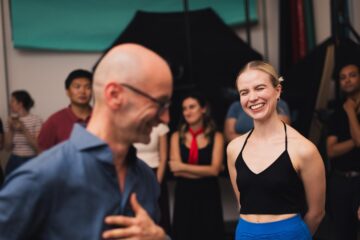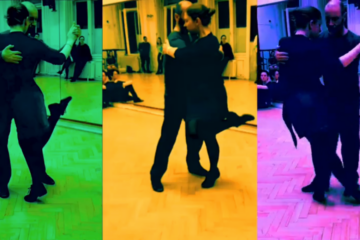Anyone who has attended one of our classes has probably been told at least once to relax and lower their shoulders. Now, let me show you why we keep repeating this mantra.
We have a few tried and true phrases for this topic. I often say, “Slide your shoulder blades into your back pockets!” Or, I might simply appear behind the student and, with a palm strike worthy of a professional masseuse, send their shoulders (which are hanging out at ear level) back to their proper place, accompanied by a gentle command: “Relax and breathe!” Don’t worry, that’s just a playful exaggeration—I don’t actually hit anyone in class 😉
But relaxing the muscles of the shoulder girdle and neck is truly essential to experiencing the freedom, flow, and deep joy of dancing. Nothing illustrates the importance of the shoulder blade better than the fact that our resident Argentine maestra, Antonella, learned this word in Hungarian very early on.
What is this post about? A brief summary
Since I tend to talk a lot and have tried to thoroughly gather the relevant information on this topic, here’s a short summary for those who may not have time to read the full article. Think of this as a teaser—I hope you’ll come back to read the full piece, it’s worth it, I promise!
The neck-shoulder-upper back area takes on a lot of strain due to our prolonged sitting and poor posture, and it’s also where much of the stress we experience is stored, leading to significant tension in these muscles. This manifests in two ways during tango:
● Firstly, we use the muscles of the shoulder girdle to compensate for work that should be done elsewhere (core, legs), either because we don’t yet have full control over our bodies or because we don’t feel the difference between a toned muscle and an overstrained one—resulting in stiff, rigid, and choppy movements.
● Secondly, this tension can affect the flow of information between leader and follower, and of course, the quality of the embrace—just to mention the two most important aspects.
● Additionally, because we have to focus on so many things at once, it creates a stressful situation to which the body naturally responds by raising the shoulders.
What can you do? First, become aware of the tension and focus on relaxing your shoulders and lengthening your neck. Secondly, watch the video below, which clearly demonstrates the cause-and-effect relationship between arm and shoulder blade movement. Try out the movements, both the incorrect and correct versions, to really feel the difference and teach your body what to aim for.
Minimal Anatomy
I’m not aiming to give an anatomy lesson, but I’ve included a few images of the muscles in this area to show you how many different muscles are responsible for the movements that occur here. Look for the trapezius muscle, the rhomboid minor and major muscles, and the levator scapulae muscle on the diagram—you’ll need to know them later!
There are two more important things to know:
● First, due to prolonged and improper sitting and general poor posture (e.g., forward head posture, rounded shoulders, humpback, increased thoracic kyphosis), these muscles are already under significant strain. This strain is biomechanically improper, which can lead to compensation and, in the worst case, deformities.
● Second, this area is prone to accumulating stress—phew, how lovely, right? No wonder that when you go for a massage, and you don’t have any specific musculoskeletal complaints, the masseuse will still spend a lot of time on your neck, shoulders, and upper back.
You can also clearly see from the diagrams how interconnected these areas are: if you look at the muscle attachment points (origin and insertion), you’ll see that the vertebrae, collarbone, scapula, and base of the skull are all involved. It’s no surprise, then, that tension in the neck-upper back area can even cause headaches.
What do we see in tango class?
I hope you’re still with me 🙂 What we usually encounter in tango class is that we raise our shoulders and/or over-tense this area in some way, leading to stiff and rigid movements, and choppy motion. This tension can affect the flow of information between leader and follower and, of course, the quality of the embrace—just to mention the two most important aspects. The reason for this is usually that we don’t yet have full control over our bodies, specifically which muscles to engage for certain movements, so we end up compensating: trying to solve something with our shoulders and arms that should be done by connecting to the ground and engaging our legs and core. Another reason could be that we don’t yet feel (yet!) the nuances between completely relaxed, toned, and fully tensed muscles. The other reason is stress: there are so many things to pay attention to that our bodies (and sometimes our minds) desperately try to take control of the situation. This is completely understandable, so don’t despair—the situation will improve with time. You can help yourself by being aware that relaxing your neck and shoulders helps, and by focusing on this during the dance.
From the outside, what we see is that you raise your shoulders—the distance between your shoulders and ears shortens—and your shoulder blades “pop out” instead of lying flat against your back. The main culprits are the trapezius, rhomboid, and levator scapulae muscles. Take another look at where they are, where they originate, and where they insert!
So, what next?
The reason for this post is the video below. Years ago, Facebook suggested it, but it has since disappeared from there, and I can’t find the source anymore. I thought it was lost forever, but a few days ago I found it—I had saved it back then. I was so happy that I decided it was time to share it again! I remember sending it to my Pilates students back then too—the “shoulder blades in your back pocket” mantra isn’t just popular in tango class 😉
The video likely shows an instructor summarizing and demonstrating the correct way to move the arms and the most common mistakes people make—highlighting the role of the shoulder blade. This is relevant for us as tango dancers because during the dance, both our arms are raised, and all movements are performed from this position. If something is wrong here (e.g., we move from the wrong place or with the wrong technique), it will affect our posture and dance.
What happens in the video?
00:35-01:10
The shoulder blades in all possible wrong positions – notice that while in their natural position they lie smoothly against the back and all muscles are relaxed, in the other positions something is always tense.a lapockák nem maradnak hátul és nem zárnak (közelítenek a gerinchez), hanem szét kell simogatni őket azzal, hogy hosszan kinyúlsz a karokkal és közben a vállakat lefelé küldöd, de nem ejted be őket előre (ekkor a lapockák ugyan szétcsúsznak oldalra, de a váll befeszül)
00:35-01:10
Raising the arms to the side – the shoulder blades don’t stay back and close (towards the spine), but should be smoothed out by reaching long with the arms while sending the shoulders down, without dropping them forward (in this case, the shoulder blades slide sideways, but the shoulder tenses up).
01:10-01:40
Raising the arms overhead – I show this in class too. Let the shoulder blade rotate inward as you raise your arm, don’t lock it in place and don’t raise your shoulder! Notice the difference in the range of motion when the movement is shown with correct and incorrect technique.
01:40-01:56
Shoulder rotation to the side – don’t bring the shoulder blades closer together, but keep your back “wide” and the movement free.
01:56-02:13
Closing/locking from a side rotation – make sure your shoulder doesn’t fall forward, maintain the distance between the inner end of the collarbone and the acromion during the closure (if your shoulder falls, it’s as if this distance shortens).
02:13-02:32
Opening-closing arms raised to the side – the key is the long movement: reach far with the arms and lower the shoulders, don’t let the neck and trapezius muscles tense up. If done correctly, you will feel lightness between the shoulder blades, and most of the muscle work will be felt on the sides of the back, at the level of the ribcage (this is the latissimus dorsi). If done incorrectly, you will feel a strong tension between the shoulder blades and almost nothing on the sides of the back. Also, pay attention to how your shoulders feel: when are they stiffer, when are they more relaxed?
02:32-02:55
Pulling the arm back – the most common mistake is that when pulling the arm back, the shoulder automatically falls forward, and as a result, the shoulder blade also rises (the arm forms an angle of about 90° with the torso). Keep your shoulder in place and relax it, then pull your arm back (in this case, it will form an angle of about 45° with your torso). It’s important that we don’t want to lift the arm up, but pull it back!
I can’t imagine a more illustrative video, and it certainly helps that the woman has such a well-developed back, it’s truly amazing! But really, everything is visible!
How can you learn from this?
I suspect everyone’s head is buzzing with all the information right now, which is completely normal. Let it settle for a while, maybe watch the video a few more times later, and go through the article again.
If this all starts to feel a bit more familiar, I suggest trying out everything shown in the video. You can start with just one movement at a time, which is why I’ve broken it down for you, step by step. Observe your body and the sensations. If you’re not alone, ask for help: a hand on your back can help you better feel the movements, and you can ask for feedback as well. If you’re alone, but can position mirrors to see your back, that can help too. But you can do all of this without a partner or mirrors; just perform each movement very consciously and pay close attention to every nuance of your body’s reactions. After all, there won’t be a mirror during the dance to correct yourself 😉
The goal is to feel how good it is to perform these movements from the right place, so that during the dance you have something to refer back to when you need to focus on twenty-six other things. Such an anchor helps you quickly reset and learn new movements correctly.
Happy experimenting!
Cover Image: Michelangelo – “Seated Male Figure” (1511)


